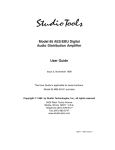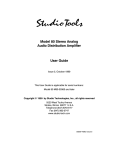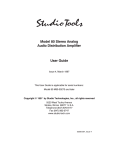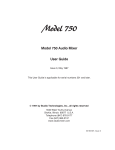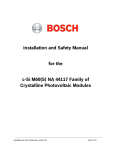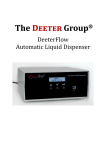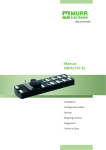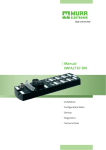Download M82 User Guide_1 - Studio Technologies, Inc.
Transcript
Model 82 Stereo Analog Audio Distribution Amplifier User Guide Issue 1, January 2000 This User Guide is applicable for serial numbers: Model 82 M82-00151 and later Copyright © 2000 by Studio Technologies, Inc., all rights reserved 5520 West Touhy Avenue Skokie, Illinois 60077 U.S.A. Telephone (847) 676-9177 Fax (847) 982-0747 www.studio-tech.com 50205-100, Issue 1 Table of Contents Foreword...................................................................... 5 Introduction .................................................................. 7 What This User Guide Covers ................................. 7 System Overview ..................................................... 7 System Features ...................................................... 7 Installation .................................................................... 8 Configuration ............................................................... 10 Operation ..................................................................... 11 Troubleshooting ........................................................... 11 Technical Notes ........................................................... 12 Specifications............................................................... 13 Block Diagram Model 82 User Guide Studio Technologies, Inc. Issue 1, January 2000 Page 3 This page intentionally left blank. Issue 1, January 2000 Page 4 Model 82 User Guide Studio Technologies, Inc. Foreword I am pleased to present the Model 82 Stereo Analog Audio Distribution Amplifier. As president of Studio Technologies, I take a very personal approach when designing products. Getting older (43 as of this writing) has increased my appreciation of the more subtle things in lifebe they a part of nature or the nuances contained in a well-designed piece of electronic equipment. Do the technical and operational aspects of a product work together to feel right? A Studio Technologies design is ready to go only when I am completely satisfied. Many fine people worked toward making the Model 82 happen. Mitch Budniak (ace consulting engineer) designed many of the circuits. Jim Cunningham contributed to the analog design. Carrie Loving provided engineering support. Al Lux designed the printed circuit board. Fred Roeck performed the mechanical design. Joe Urbanczyk coordinated the safety testing and agency approvals. Please contact me with your questions, comments, and suggestions. I can be reached by voice at (847) 676-9177, fax at (847) 982-0747, or via the Internet @ www.studio-tech.com. Sincerely, Gordon K. Kapes President Model 82 User Guide Studio Technologies, Inc. Issue 1, January 2000 Page 5 This page intentionally left blank. Issue 1, January 2000 Page 6 Model 82 User Guide Studio Technologies, Inc. Introduction The Model 82 Stereo Analog Audio Distribution Amplifier was developed by Studio Technologies as part of its Studio Tools group of audio support products. The Model 82 is designed to work in a large variety of applications. Specific applications include audio production, duplication, broadcast, and sound reinforcement. All Model 82 functions meet or exceed the performance of the most expensive high end audio equipment. What This User Guide Covers This User Guide is designed to assist you when installing, configuring, and using the Model 82 Stereo Analog Audio Distribution Amplifier. System Overview The Model 82 from Studio Technologies, Inc. is a distribution amplifier that truly meets the needs of the real world. The stereo input is intended to connect to virtually any line-level audio source. The ExactCal input calibration section allows optimal audio performance to be achieved over a nominal input level range of 12dBV to +6dBu. The four stereo outputs meet exacting professional standards. Capable of driving balanced or unbalanced loads, each output can drive +26dBu into 600 ohms. Using front panel switches, each stereo output can be individually configured for a nominal output level of 10dBV or +4dBu. The front-panel trim potentiometers and LEDs make calibration and use simple. The AC mains input power is factory configured for 100, 120 or 220/240V, 50/60Hz operation. Components and Model 82 User Guide Studio Technologies, Inc. construction standards make the Model 82 suitable for continuous operation, even for on-air broadcast applications. System Features One Stereo Input The differential input circuitry is compatible with balanced or unbalanced signals having a nominal level range of 12dBV to +6dBu. Using laser-trimmed components, the stereo input offers superior commonmode signal rejection. To achieve optimal audio performance the ExactCal calibration section matches the installationspecific nominal input level with the Model 82s internal gain structure. Two 15-turn trim potentiometers and four LEDs allow fast, precise calibration. Unlike other distribution amplifiers, the Model 82 ensures that excellent audio performance can be achieved with little or no hassle. Four Stereo Outputs The Model 82 contains four independent stereo output sections. For compatibility with a range of facilities, each output section can be separately configured for a 10dBV or +4dBu nominal output level. Each output features an electronically balanced circuit capable of driving balanced or unbalanced loads. And, unlike some output circuits, operating a Model 82 output in an unbalanced configuration does not cause a change in the nominal output level. Short circuit resistant, the rugged output circuits can drive full signal levels into 600 ohm or greater loads. The Model 82s architecture precludes the need for individual output-level trim potentiometers. With the input signal calibrated using the ExactCal section, the four stereo outputs use 1%-tolerance components Issue 1, January 2000 Page 7 to provide precise 10dBV or +4dBu outputs. Audio Performance The Model 82 is the result of exacting circuit design combined with the latest state-of-the-art components. Like all Studio Technologies products, the Model 82 has survived tough listening evaluations by industry professionals. These veterans have the ears to guide us in achieving the right performance. The outcome is a product that achieves sonic excellence. Design Philosophy Most audio distribution amplifiers contain a level trim adjustment on each output. After careful study Studio Technologies concluded that these adjustments confused, and often interfered with, the process of getting maximum audio performance. After checking with personnel in the field, it became clear that what is desired in virtually every distributionamplifier applications are multiple audio outputs all operating at a standard reference level. By implementing the ExactCal system, the Model 82s internal operating level can be easily calibrated to match that of the input signal. Once this input level matching is accomplished the four stereo outputs can be individually configured for 10dBV or +4dBu nominal operating level. In conclusion, output trim pots are not included on the Model 82 for the simple reason that better audio performance can be achieved without them! Installation In this section you will be installing the Model 82 in an equipment rack. Audio input, audio output, and AC mains power connections will be made. Model 82 Front Panel Power present LED Left and right input trim controls Input level calibration LEDs 10dBV or +4dBU output level configuration switches Model 82 Back Panel AC mains connection Issue 1, January 2000 Page 8 Stereo line-level outputs Stereo line-level inputs Model 82 User Guide Studio Technologies, Inc. System Components The shipping carton contains a Model 82, User Guide, and warranty card. Units destined for North America are shipped with an AC mains cord. Your dealer or distributor will provide an AC mains cord for non-North American destinations. low ( or cold), and pin 1 is shield. With an unbalanced source, connect pin 2 to high (+ or hot), and pins 1 and 3 to shield. If connecting to an unbalanced source in this manner results in hum or noise, try connecting pin 2 to high (+ or hot) and pin 3 to shield; leave pin 1 unterminated. Mounting the Model 82 Audio Outputs The Model 82 contains four independent stereo line-level outputs. The outputs are electronically balanced and capable of driving balanced or unbalanced loads of 600 ohm or greater. The outputs can be individually configured for a nominal output level of 10dBV or +4dBu, so you can connect to all line-level inputs with no hassle. The Model 82 requires one space in a standard 19-inch (48.3cm) equipment rack. It is desirable to locate the Model 82 to allow easy access to both the front and the back panels. The back panel contains the input and output connectors. The front panel is used to access the calibration controls and output-level switches. The front panel also contains four LED level indicators. The Model 82 is secured to the equipment rack using two mounting screws per side. Audio Input The Model 82 provides one stereo linelevel input. It is electronically balanced, and compatible with balanced or unbalanced signals that have a nominal level range of 12 dBV to +6dBu. The ExactCal section allows precise level calibration with the connected input signal. The configuration section of this guide provides details on using the trim pots. It is anticipated that in most cases a stereo signal will be connected to the input. The Model 82 can also be used as a 1-input/ 8-output monaural distribution amplifier, or as a dual 1-input/4-output monaural distribution amplifier. Two 3-pin female XLR-type connectors are used to interface with the input source. Prepare the mating connectors (males) so that pin 2 is signal high (+ or hot), pin 3 is Model 82 User Guide Studio Technologies, Inc. Eight 3-pin male XLR-type connectors are used to interface with the Model 82's outputs. Prepare the mating connectors (females) so that pin 2 is signal high (+ or hot), pin 3 is low ( or cold), and pin 1 is shield. To connect to an unbalanced load connect pin 2 as signal high (+ or hot), and pins 1 and 3 as signal low/shield. For optimal unbalanced operation, it is important to connect pins 1 and 3 together directly on the connector that mates with the Model 82, and not on the other end of the cable. Note that while the Model 82s electronically balanced output circuits are capable of driving loads of 600 ohms or greater, the output level will drop slightly as the load impedance approaches 600 ohms. A 0.5dB difference in output level can be expected as the load impedance changes from 10k ohms to 600 ohms. AC Mains Power The Model 82 is internally configured to operate from either 100, 120, or 220/240V, Issue 1, January 2000 Page 9 50/60Hz. In most cases, units shipped to North America are factory selected for 120V operation. Units bound for Japan are selected for 100V, while our friends down under and in Europe receive units set for 220/240V. Before connecting the Model 82 to AC mains power, check that it is configured to match the local mains voltage. Look on the back panel, adjacent to the power entry connector, for the configured voltage(s). Note that an incorrect configuration could seriously damage the unit. Should it be necessary to change the units operating voltage it must be performed only at the factory or by an authorized service technician. The Model 82 uses an IEC standard connector to mate with the AC mains cord. The wire colors in the AC mains cord should conform to the internationally recognized CEE color code and must be wired accordingly: Connection Wire Color Neutral (N) Line (L) Protective Earth (E) Light Blue Brown Green/Yellow Safety Warning: The Model 82 does not contain an AC mains disconnect switch. As such the mains cord plug serves as the disconnection device. Safety consideration requires that the plug and associated outlet be easily accessible to allow rapid disconnection of mains power should it prove necessary. As soon as mains power is connected, the Model 82s power present LED will light. The unit is now ready for years of trusty service! Issue 1, January 2000 Page 10 Configuration Input Level Calibration With the ExactCal calibration section its simple to match the nominal level of the input signal with the Model 82s internal circuitry. Two 15-turn trim potentiometers, along with four LEDs, form the ExactCal section. One trim pot is associated with the left input, the other with the right. Two LEDs, labeled Lo and Hi, are associated with each input. They are provided as an aid to calibration, as well as serving as signal present indicators. The following is a step-by-step procedure for using the ExactCal section to match an input signal to the Model 82's circuitry: Set the trim pots to their fully counterclockwise position. Remember, the trim pots are 15-turn type, so you may have to rotate them up to 15 times before reaching their fully counterclockwise position. Supply a 1kHz sine wave to both the left and right inputs. Set the level of the source to be precisely the nominal operating level. If, for example, the output of a console is connected to the input of the Model 82, the console output should be adjusted so that the meters read 0dB or 100%. If the output of the console is a +4-type, then setting the consoles left and right output levels to nominal should find the console output levels to be exactly +4dBu. Slowly turn the trim pot associated with the left input in the clockwise direction. As you increase the level, watch the LEDs associated with the left channel. Model 82 User Guide Studio Technologies, Inc. The LED labeled Lo will light first, then both LEDs will light, then only the LED labeled Hi will light. The correct setting is where both LEDs light their brightest. Careful adjustment is required as the window where both LEDs light is somewhat less than 1dB. Repeat the above procedure for the trim pot and LEDs associated with the right input. When the configuration is correct both LEDs associated with the right channel input will be lit to their brightest. Disconnect the 1kHz signal and connect the normal audio source. Output Level Selection Each of the four stereo line-level outputs is individually configurable for a 10dBV or +4dBu nominal output level. Four DIPtype switches, located on the right side of the front panel, are used to set the output levels. The legend on the switches correspond to the output channel numbers. A switch that is set to its up position configures its associated output channel for 10dBV. A switch set to its down position configures the output for +4dBu. A small screw driver may be of assistance when setting the switches. Operation Now that youve installed and configured the system, youre ready to go. You should find operation very easy, as there is nothing to do on a day-to-day basis. For peace of mind, the ExactCal LEDs will give you a visual indication whenever audio signals are present on the Model 82s input. Model 82 User Guide Studio Technologies, Inc. The LEDs labeled Lo will light whenever an input signal is within the range of 18dB below and 0.5dB above the nominal operating level. The LEDs labeled Hi will light any time an input signal is greater than 0.5dB below the nominal operating level. This sounds a bit confusing but isnt really so hard to understand. As an example, if you have a nominal +4 signal connected to the Model 82s line input and the ExactCal section has been used to calibrate the input, the Lo LEDs will light whenever the signal is between 14 and +4.5dBu, the Hi LEDs will light whenever the signal exceeds 3.5dBu. The four outputs are fully independent. You can patch, reconnect, or even short out an interconnecting cable without effecting the other outputs. Using the front-panel DIP switches you can change the output level of any or all of the outputs whenever you wish. Remember that if you change the input source you may need to use the ExactCal section to recalibrate the input. Refer to the configuration section of this guide for details. Troubleshooting If youre having problems getting the Model 82 up and running, this section can help. If you havent read the other sections of this guide, you should do so before proceeding. If the Model 82 Doesnt Work At All A source of AC mains power must be connected to the Model 82. Depending on the version you have purchased, 100, 120, or 220-240Vac, 50/60Hz is required. Confirm what mains voltage is required by Issue 1, January 2000 Page 11 observing the selection boxes to the left of the AC mains connector on the back panel. Whenever mains power is connected the front panel power present LED should light. If the LED is not lit confirm that AC mains power is active (hot) and that the cord is securely mated with the connector on the Model 82's back panel. For safety in the event of a major internal failure or the connection of incorrect AC mains voltage, the Model 82 contains a fuse inside its cabinet. The fuse will open (blow) if the failure of an internal component causes excessive current to be drawn from the internal power supply. The fuse will also open should 220-240Vac be connected to a Model 82 that is configured for 100 or 120Vac operation. The fuse is intended to be replaced only by a competent service technician. This person will have the training to safely access the guts of the Model 82 and identify where a problem is located. Incorrect Output Levels You must correctly set the input trim pots so that the four stereo outputs can provide precise 10dBV or +4dBu nominal output levels. These trim pots are used to match the nominal level of the audio input signal with the Model 82s internal circuitry. Refer to the Configuration section of this guide for detailed instructions. it was easy to say that 0dBm is 1 milliwatt dissipated in the known load (i.e., 0dBm across 600 ohms will measure 0.775V). In contemporary situations an output is rarely terminated with 600 ohms; generally 10k ohms or higher. The dBu designation is better because it refers to dB referenced to 0.775V, with no reference to load impedance. This takes into account todays audio scene where signals have a low source impedance, and a high input impedance. The dBu designation is becoming the standard for the professional audio industry. 10dBV Outputs Note that a user monitoring, by means of a level meter (e.g., a VU meter), one of the Model 82s outputs might expect to see a 14dB drop when changing from the +4 to the 10 DIP switch position. In fact, the output level will drop by only 11.78dB. This is because the output level is not only switching between "+4" and "10," but it's changing from a dBu to a dBV reference as well. As 10dBV is the same as 7.78dBu, the expected 14dB drop never occurs! Technical Notes Definition of LeveldBu Whenever possible, Studio Technologies has opted to use the dBu designation as it seems to be quite rational. Using dBm was fine when all audio line outputs were terminated with 600 ohm loads. In this way Issue 1, January 2000 Page 12 Model 82 User Guide Studio Technologies, Inc. Specifications Audio Input: 1, stereo Type: electronically balanced, direct coupled Input Compatibility: can be connected to balanced or unbalanced signals Impedance: 24k ohms Nominal Input Level: 12dBV to +6dBu Input Level Control: 15-turn trim potentiometers allow calibration over 12dBV to +6dBu input range Maximum Input Level: +27dBu Common Mode Rejection: 90dB @ DC and 60Hz, 85dB @ 20kHz, 60dB @ 400kHz (typical) Audio Outputs: 4, stereo Type: electronically balanced, direct coupled, intended to drive loads of 600 ohms or greater, can be connected balanced or unbalanced Nominal Output Level: 10dBV or +4dBu, each output individually switch configurable Maximum Output LevelBalanced: +27dBu into 10k ohms, +26dBu into 600 ohms Maximum Output LevelUnbalanced: +21dBu into 10k ohms, +20dBu into 600 ohms Output Impedance: 50 ohms Frequency Response: 10Hz-70kHz +0/0.5dB (down 1dB @ 90kHz) Distortion (THD+N): 0.004% (measured at +4dBu input, +4dBu output, 20Hz-20kHz) LED Indicators: 5, 1 power present, 4 input level calibration Fusing: 1 Type: 5 x 20mm time lag (Littelfuse 218-series or equivalent) Rating: 0.400A for 100 and 120V mains power, 0.200A for 220/240V mains power Connectors: Audio Input: 2, 3-pin XLR-type, female Audio Output: 8, 3-pin XLR-type, male AC Mains: standard 3-blade plug, meets IEC 320 specifications AC Mains Requirement: 100, 120, or 220/240V, ±10%, factory configured, 50/60Hz, 100-120V 0.4A maximum, 220/240V 0.2A maximum Dimensions (Overall): 19.00 inches wide (48.3cm) 1.72 inches high (4.4cm) 6.65 inches deep (16.9cm) Mounting: One space in a standard 19-inch-type rack Weight: 7.0 pounds (3.2kg) S/N Ratio: 92dB (20Hz-20kHz, ref. +4dBu on input and output) Crosstalk: 86dB (1kHz, ref. +4dBu on input and output) Model 82 User Guide Studio Technologies, Inc. Specifications and information contained in this User Guide subject to change without notice. Issue 1, January 2000 Page 13 This page intentionally left blank. Issue 1, January 2000 Page 14 Model 82 User Guide Studio Technologies, Inc.















